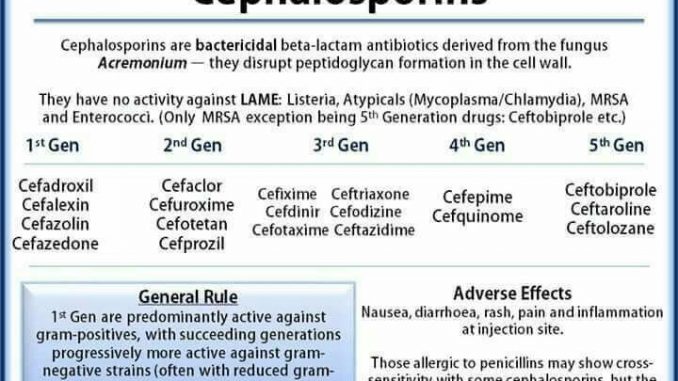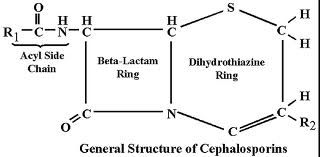
Cephalosporin: structure, classification, clinical use and mode of action
structure of cephalosporin
- Cephalosporin is a β-lactam antibiotic that inhibits bacterial cell wall synthesis. In 1948 Dr. Abraham first isolated cephalosporin C from a fungus Cephalosporium acremonium. Cephalosporins have broder gram –ve coverage than penicillin yet no one of the cephalosporins is active against MRSA and enterococci. Basic structure of cephalosporin is 7-aminocephalosporanic acid

Classification of Cephalosporin:
On the basis of spectrum of antimicrobial activity cephalosporin are classified into several generations.
i. First generation Cephalosporin:
- 1st generation cephalosporin have broad spectrum of activity and low toxicity.
- 1st generation cephalosporin are very active against gram +ve cocci such as Pneumococci, viridans streptococci, β-hemolytic streptococci and staphylococci.
- They are effective against gram –ve rods such as coli, Klebseilla pneumoniae, proteus mirabilis but have very little activity against Pseudomonas aerogenosa, Proteus vulgaris, Enterobacter, Citrobacter, Serratia and Acinetobacter.
- They are also active against anaerobes like Peptococcus and Streptococcus but ineffective against Bacteroids fragillis.
- None of the 1st generation cephalosporin can cross brain barrier. Therefore they cannot be used for treatment of meningitis.
List of 1st generation cephalosporin;
- Cephalexin:
- Cephradine
- Cephalothin
- Cefadroxil
- Cefuzolin: drug of choice for surgical prophylaxis
- Cephapirin
ii. Second generation Cephalosporin:
- 2nd generation cephalosporin have extended gram-ve coverage than that of 1st generation cephalosporin.
- They are heterogenous groups of antibiotics with different antimicrobial activity.
- They are active against Enterobacter, Proteus vulgaris, Klebsiella, H. influenzae
List of 2nd generation cephalosporin:
- Cefamandole
- Cefonicid
- Cefmetazole
- Cefaranide
- Cefprozil
- Cefuroxime
- Cefpodoxime
- Cefoxitin
- Cefotetan
- Cefaclor
- Loracarbef
** cefaclor is used in treatment of sinusitis and otitis caused by β-lactamase producing strain of H. influenza, especially in patient allergic too Ampicillin and Amoxicillin
iii. Third generation cephalosporin:
- 3rd generation cephalosporin have extended spectrum of activities and they have extended gram –ve coverage including Citrobacter, Enterobacter, Provedeneia, Pseudomonas aerogenosa and β-lactamase producing meningococci and H. influenzae.
- This generation cephalosporin are usually used in treatment of sepsis of unknown origin especially in immunocompromised patients in in those individuals where cephalosporin possess least toxicity.
List of 3rd generation cephalosporin:
- Cefoperazone
- Ceftizoxime
- Ceftazidime
- Cefixime
- Cefotaxime
- Moxalactame
- Ceftriaxome
** All 3rd generation cephalosporin except cefoperazone and cefixime can cross blood brain barrier and therefore can be used to treat meningitis.
iv. Fourth generation Cephalosporin:
- 4th generation cephalosporin have extended gram –ve coverage and they have increased activity against Streptococci and MRSA.
- The activity of 4th generation cephalosporin can be comparable to Ceftazime against Pseudomonas.
List of 4th generation cephalosporin
- Cefepime
- Cefpirome
v. Fifth generation Cephalosporin:
- They are extended cephalosporin with extended spectrum of activities against MRSA
List of 5h generation cephalosporin;
- Ceftaroline
- Ceftabiprole
Mode of action of Cephalosporin:
i. Binds to penicillin Binding Protein (PBP):
- Many of the cephalosporin eg. Cephalexin, cefotaxime and ceftazidime binds to Penicillin binding protein 3 (PBP3) similar to action of penicillin and results in formation of elongated and filamentous cell. Transpeptidase is the enzyme present in bacteria that cross linked with existing peptidoglycan chain and maintain integrity of cell wall. Binding of cephalosporin on PBP3 receptor deforms cell wall and kills bacteria.
ii. Activation of autolysin:
- Cephalosporin also activates autolytic enzymes in bacteria and causes lysis of bacteria
